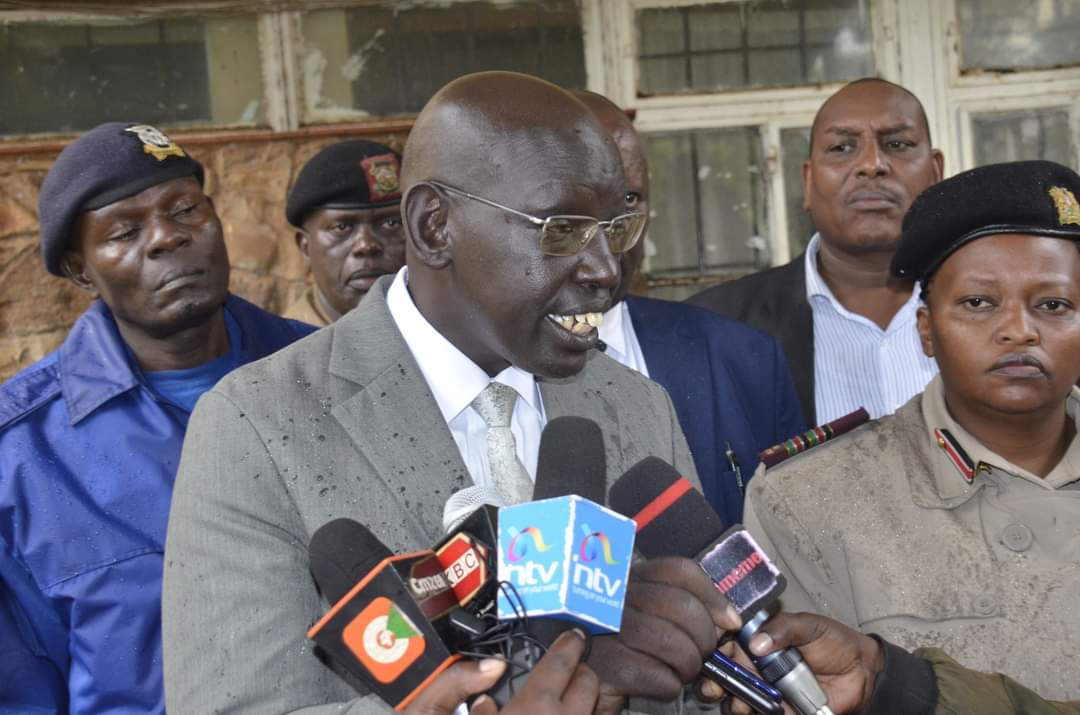ELECTRONICS
- Sketch curves to show the variation of current and time as displayed on the CRO in each of the
- State the majority carriers for a p-type semi conductor.
- a) Using examples explain the difference between a semiconductor and a good conductor.
- b) A radio repairer wishes to use an ammeter to detect a faulty diode. With the aid of a circuit diagram describe how he will go about this task.
- Using examples, explain the difference between a semi conductor and a good conductor.
- p- type and n-type semiconductors are made from a pure semiconductor by a process known as “doping”.
- i) What is doping?
- ii) Explain how the doping produces an n-type semiconductor.
- Sketch a current-voltage characteristic of a junction diode with a forward bias.
- Using the components symbols shown in the fig, sketch a series circuit diagram for a forward biased diode.
Hot Downloads!!
Physics Topic By Topic Questions And Answers (All Topics)
Free Physics notes, revision questions, KCSE past Papers, Exams, Marking Schemes,…
Free Secondary and Primary school notes, exams, schemes, lesson plans, revision…
Free updated schemes of work for all subjects (Secondary; Form 1-4)
KCSE Topical Revision Resources For All Subjects (Topic By Topic Questions…
Topic by Topic Revision Questions Free Downloads (All Form 1, 2,…
More Free Physics Resources.
PHYSICS FORM ONE NOTES LATEST
Free Physics notes, revision questions, KCSE past Papers, Exams, Marking Schemes, Topical revision materials, Syllabus and Many more
Physics free lesson plans for all topics (Form one to four)
Physics Simplified Notes Form 1 to 4 Free
Physics Topic By Topic Questions And Answers (All Topics)
Physics Form 3 Notes, Revision Questions And Answers
Physics Form 2 Notes, Revision Questions And Answers
- (a)
- i) Distinguish between semiconductors and conductors
- ii) Give an example of a semiconductor and one for a conductor.
- In the circuit below, when the switch s is closed, the voltmeter shows a
When the cell terminals are reversed and the switch is closed, the voltmeter reading is zero.
Explain these observations.
- What is meant by Donor Impurity in semiconductors?
- You are provided with a diode, a resistor R, an a.c source of low voltage and connecting wires. In the space provided, sketch the circuit diagram for a half-wave rectifier and indicate the terminals where the output voltage v0 may be connected.
- Explain how doping produces an n-type semiconductor for a pure semiconductor material.
- Distinguish between intrinsic and extrinsic semi-conductors.
- The diagram below shows a rectifier circuit for an alternating current (a.c) input.
- i) Describe the rectification process.
- ii) Draw the traces of the signal obtained on CRO connected across QS and PR.
- The figure 8 below shows a bridge rectifier.
Figure 8
- i) Define the term rectification.
- ii) Describe how the illustrated rectifier works.
iii) State the modification that can be made on the arrangement to improve the quality of the output.
- iv) Sketch on the grid below how the improved output is displayed on a C.R.O screen.
- a) Distinguish between intrinsic and extrinsic conductors
- b) You are provided with 4 diodes, A resistor, an a.c of low voltage and enough connecting wires.
- i) In the spaces provided below, sketch the circuit diagram for a full wave rectifier and indicate the terminals where the output voltage v may be connected.
- ii) On the axes provided below, sketch the graph of output voltage against time for the rectifier
- c) A capacitor is now connected across the output. Explain its effect on the output.
- (a) Define doping
(b) Distinguish between a p-type and n-type semi conductors
(c) The figure 14 below shows a bridge circuit
A capacitor has been connected across the resistor as shown
(i) Sketch the wave form when a C.R.O is connected across the resistor, R
(ii) On the same axes, sketch a wave form when a C.R.O is connected across R and when the capacitor has been removed.
- The figure below shows a bridge rectifier.
|
|
|
|
- i) Define the term rectification.
- ii) Describe how the illustrated rectifier works.
iii) State the modification that can be made on the arrangement to improve the quality of the output.
- iv) Sketch on the areas below how the improved output is displayed on a C.R.O screen.
- The figure 5 below shows a block diagram of a p-n junction diode.
On the same diagram, show how a cell may be connected so that it is reverse biased.
Fig 5
- Figure 4 below shows the supply of d.c. to a resistor, R through a diode, D.
-
- Give the bias of the diode.
- An a.c supply is now supplied to the resistor R. On the axes provided below, sketch the output observed in the C.R.O connected across R.
- a) A student connected a circuit as shown in figure 13 below hoping to produce a rectified output.
- i) Sketch the graph of the output on the CRO
- ii) Explain how the output above is produced.
iii) Name other two uses of a junction diode.
- In the figure below, the voltmeter shows a reading when the switch S is closed.
When the cell terminals are reversed and the switch closed, the voltmeter reading is zero. Explain this observation.
- (a) Define the term doping.
- The diagram below shows a bridge rectifier for alternating current. Complete the diagram by placing the diodes in the correct order.
(c) Explain why a bridge rectifier circuit is better than a single diode rectifier circuit.
(d) What happens to depletion layer when diode is reverse biased.
- (a) You are provided with a 12V a.c. source, four diodes and a resistor.
- i) Draw a circuit diagram for full wave rectifier and show the points at which the output is taken
- ii) Sketch a graph of voltage against time before rectification.
iii) Sketch a voltage – time graph after rectification.
- iv) Sketch a voltage –time graph after rectification with a capacitor connected across the resistor in (i)
- b) A radioactive sample of half life 130 days initially has 1.0x 1020 radioactive atoms. Determine the number of radioactive atoms that would have decayed after 390 days.
- In the figure shows a rectifier circuit for an alternating current input.
(a) On the circuit, indicate the flow of current to illustrate rectification.
(b) Sketch a graph to show how the voltage across R varies with time.
- (a) (i) State the meaning of the statement diode characteristic.
(ii) Sketch a circuit diagram that can be used to investigate p-n junction diode characteristics.
- Define the term acceptor atom as applied in semiconductor.
- Study figure 7 below and use it to answer questions that follow.
- Briefly explain how the circuit works to produce a rectified alternating current.
- Draw on the diagram to show the position of the capacitor.
- State the functions of the capacitor in the circuit.
- Sketch the graph of the output as seen on a CRO screen.
- The figure below shows a bridge rectifier.
|
|
|
|
- i) Define the term rectification.
- ii) Describe how the illustrated rectifier works.
iii) State the modification that can be made on the arrangement to improve the quality of the output.
- iv) Sketch on the areas below how the improved output is displayed on a C.R.O screen.
(b) Figure 10 shows a circuit whose output voltage with time as displayed on the CRO screen.
(i) Sketch a graph to show the variation of output voltage with time as displayed on the CRO screen
(ii) Show on the diagram (Figure 10) how a capacitor should be connected to smooth the output voltage
(iii) Sketch a curve of smoothed output voltage against time.
- (i) Using a diagram explain how doping produces a p-type semi-conductor.
(ii) What is biasing?
(iii) The diagram below shows a circuit with a p-n junction and a very low power bulb.
State with reason the observations made on the bulb when the switch is closed.
- (a) (i) Distinguish between intrinsic and extrinsic conductors
(ii) The figure bellows shows a p-n junction diode.
Complete the diagram to show the forward bias state
(b) Extrinsic semiconductors are made through a process called doping. Explain how doping produces an n-type semi conductor
(c) On the axes shown below, sketch a current-voltage characteristic of junction –diode
(d)The figure below shows a rectifier circuit for an alternating current input using four diodes
|
- Explain how rectification is done
- State the function of the capacitor
- Sketch a graph to show how the p.d. across the resistor R varies with time.
- Figure below shows two ways of biasing a P.N junction.
(i) In which circuit will current flow?
(ii) Explain your answer in (i) above.
- Figure below shows a circuit consisting of ideal diodes.
Determine the current flowing through the resistors
- The diagram below shows a junction diode.
P n
Complete the diagram to show how the diode can be connected in a reverse bias mode.
- a) Explain how doping produces a p-type semi conductor for pure semi conductor material.
- b) You are provide with 4 diodes, A resistor, an a.c of low voltage and enough connecting wires
- In the spaces provided below, sketch the circuit diagram for a full wave rectifier and indicate the terminals where the output voltage v may be connected.
- On the axes provided below, sketch the graph of output voltage against time for the rectifier
Output voltage
time
- A capacitor is now connected across the output. Explain its effect on the output.
- (a) Explain why the conductivity of a metallic conductor decreases with increase in temperature while that of an intrinsic semiconductor increases with increase in temperature.
(b) Explain what happens to the depletion layer when diode is reverse biased.
(c) Find the current flowing and the voltage across the 8W resistor in the circuit.
(d) The figure shows a circuit used for a full wave bridge rectification.
(i) Insert diodes D1, D2, D3 and D4 to complete the circuit.
(ii) What is the use of capacitor C?
(iii) On the axes below draw a voltage – time display of the
rectification observed on the C.R.O.
- a) Explain the following terms:
- Extrinsic semiconductor:
- Dopping:
- b) i. Explain briefly the dopping process involved in making n-type semiconductor.
- Draw a circuit diagram to illustrate a forward biased p-n Junction
- c) In an experiment to investigate the variation of voltage with current for certain p-n Junction diode.
| p.d(voltage) | 0 | 1.0 | 1.2 | 1.4 | 1.6 | 1.8 |
| Current (mA) | 0 | 3.0 | 9.0 | 19.0 | 32.0 | 60.0 |
- Draw a circuit diagram that can be used to obtain results in the table above.
- Plot a graph of current against p.d on the grid provided.
iii. Find the resistance when the voltage is 1.3V
- a) Figure below shows a circuit of a rectifier using two diodes D1 and D2
- Explain how rectification output is produced from the set up when an a.c input in connected across AB.
- On the axes provided, sketch the graph of output voltage against time for the rectifier.
iii) A capacitor is now connected across XY. Explain the effect of the capacitor on the output.
- b) Explain how doping produces an n- type semi conductors from a pure semi conductor material.
- c) Briefly explain what happens to the depletion layer when a diode is forward biased.
- d) What is a zener diode?
- (a) Explain how you can obtain an n-type extrinsic semiconductor.
(b) What do you understand by term full wave rectification of A.C ?
(c ) The figure below shows a bridge rectifier
(i) Describe how the illustrated rectifier works.
(ii) State the modification that can be made on the arrangement to improve the quality
of the output.
(iii) Sketch on the axes below how the improved output is displayed on a C.R.O screen. ( 1 mark )
- Figure 10(a) and 10(b) shows a p – n junction connected to a battery. It is observed that the current in figure 10(a) is greater than the one in figure 10(b)
State the reason for this observation
- a) Distinguish between a conductor and a semi conductor
- b) What is meant by doping?
- c) Give the difference between intrinsic and extrinsic semiconductor.
- d) Using examples explain the difference between n-type and p-type semiconductor.
- e) The diagram below shows a circuit for full wave rectification.
- i) Insert diodes in the gaps left
- ii) Explain how the rectifier works
iii) A CRO is connected across R, draw the wave output display.
- a) Give two differences between P – type and n – type semiconductor
- b) Explain using a diagram how a diode can be used as a half-wave rectifier
- c) Figure below shows the output of a wave from an a.c source
Using a circuit show how the above output is produced
- d) Name two ways of enhancing the conductivity of a semiconductor
- Figure below shows two identical diodes connected in a circuit.
State and explain what happens to each lamp when the switch is closed.
- Below is part of a circuit that was set up by form four students of Okok Secondary school during a physics practical lesson to demonstrate full wave rectification using two diodes.
Complete the circuit by correctly placing the load R and the two diodes
- a) Figure below shows a circuit of a rectifier using two diodes D1 and D2
- Explain how rectification output is produced from the set up when an a.c input in connected across AB.
- On the axes provided, sketch the graph of output voltage against time for the rectifier.
iii) A capacitor is now connected across XY. Explain the effect of the capacitor on the output.
- b) Explain how doping produces an n- type semi conductors from a pure semi conductor material.
- c) Briefly explain what happens to the depletion layer when a diode is forward biased.
- d) What is a zener diode? (1mk)
- When a radiation was released into a diffusion cloud chamber, short thick tracks were
State with a reason, the type of radiation that was detected.
(b) The half-life of an element X is 3.83 days. A sample of this element is found to have an activity rate of 1.6 x 101 disintegrations per second at a particular time.
Determine its activity rate after 19.15 days.
(c) State what is meant by an extrinsic semiconductor.
(d) Figure 12, shows n depletion layer in an unbiased p-n junction.
State how a battery can be used to make the depletion layer narrower.
(e) Figure 13, shows an incomplete circuit of a full wave rectifier.
(i) Draw in the figure two more diodes to complete the circuit.
(ii) Show on the figure the points across which the output of the rectifier should he obtained.
- a) The figure below shows a bridge rectifier.
- i) Define the term rectification.
- ii) Describe how the illustrated rectifier works.
iii)What modifications can we make on the arrangement to improve the quality of the output.
- iv) Sketch on the areas below how the improved output is displayed on a C.R.O screen.
(b) The figure below shows an expansion cloud chamber.
(i) What is the purpose of the Vapour?
(ii) Explain how the radiations emitted by the radioactive source in the chamber are detected.
- (a) Distinguish between intrinsic and extrinsic semiconductors. (b) (i) A junction diode is used as a rectifier. Draw a simple circuit to show how two junction diodes and a centre tapped transformer can be used to produce a full wave rectified a.c.
(ii) Name two other uses of a junction-diode.
(c) The graph in fig. below shows a forward bias characteristic of a p-n junction.
|
|||||
|
|||||
|
|||||
The depletion layer decreases from O to A. Explain what is meant by depletion layer.
(d) What is the advantage of rectifying using four diodes instead of two?
- c) A student connected a circuit as shown below, hoping to produce a rectified output.
- i) Sketch the graph of the output as seen on the C.R.O screen.
- ii) Explain how this output is produced.
- Figure below is a circuit with 2 bulbs and components D.
Fig. 3
(i) State the observation made when switch K is closed.
(ii) Account for the observation made above.
- The figure 6 shows a p.n junction connected to a cell.
|
|
Fig 6
(i) Identify the biasing.
(ii) Represent the circuit in the correct circuit symbols.
- a) Define the following terms:
- i) Doping
- ii) Diode
- b) With the aid of a circuit diagram, differentiate between forward biased and reverse diode.
- c) Sketch a graph to show how the current through p-n junction varies with p.d across it.
- d) The figure shows an incomplete circuit for full wave rectification:-
- i) Complete the diagram to show how the diodes should be arranged for the current to flow through R in the direction shown.
- ii) Sketch the output voltage as observed in the C.R.O.





